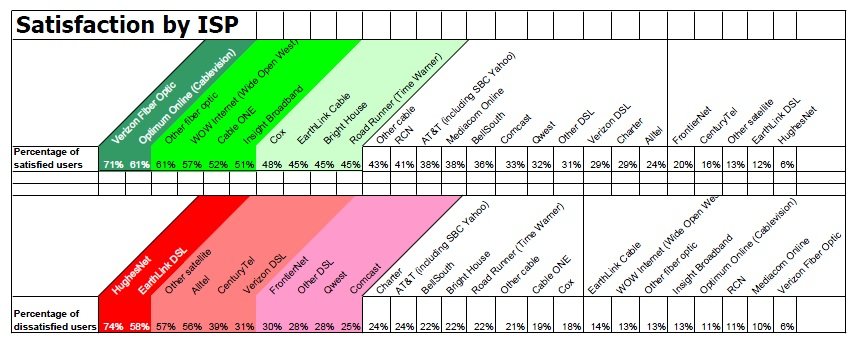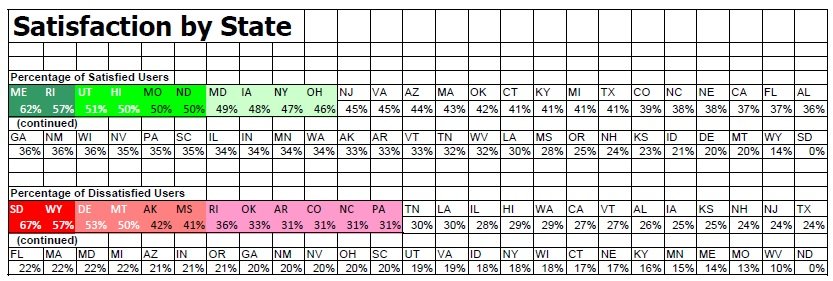Less than half of Americans surveyed by PC Magazine report they are very satisfied with the broadband speed delivered by their Internet service provider.
PC Magazine released a comprehensive study this month on speed, provider satisfaction, and consumer opinions about the state of broadband in their community.
The publisher sampled more than 17,000 participants, checking their actual broadband speeds, and questioned them about their overall satisfaction with their online access.
The findings indicate consumers live with what provider they can get. Even lower rated providers scored “satisfactory,” in part because consumers don’t have many choices with which to compare.
In the war between coaxial cable modem vs. copper wire DSL technology-of-the-1990s battle, PC Magazine declared the cable industry the winner, consistently delivering faster speeds more reliably than possible with telephone company DSL. Overall, the average cable speed was “688 Kbps, while the average DSL lets you surf at just 469 Kbps—cable connections, on average, are 47 percent faster.” Those speed measurements are based on actual web page and content delivery, not on marketed available speed.
In fact, users rated DSL an unsatisfying service, with only 20% of rural and suburban customers very impressed with DSL. But for many who have no other choice, 50% think it’s good enough.
Or better than nothing.
One DSL provider did extremely well speed-wise in PC Magazine‘s survey, however. Frontier Communications was rated as the fastest DSL provider in the nation, averaging “real-world” speeds of 724 Kbps, according to the survey. But even they could only score a 20% customer satisfaction rating, with 30% dissatisfied.
There was one technology that did much, much worse. Satellite broadband, the last possible choice for many Americans between dial-up and going without, is provided by companies like HughesNet and WildBlue, and they are unmitigated disasters in consumers’ eyes.
Just 6% of Hughes customers were satisfied, with a whopping 74% dissatisfied. That’s because satellite broadband is extremely slow, averaging just 145 Kbps, heavily capped, and very expensive. But for some rural Americans who live too far away from their local phone company central office, and will never see cable television, it’s likely their only choice. Even mobile broadband signals won’t reach many of these consumers.
So what is the good news from all of this? There is one technology that, hands-down, beats all of the rest — fiber optics to the home. The nation’s top-rated ISP in PC Magazine’s survey is Verizon FiOS, with 71% satisfied, and just 6% dissatisfied. Other fiber optic providers, mostly smaller local, regional, or municipal systems, scored 61% satisfaction. Just one cable company matched that rating – Cablevision’s Optimum Online.
AT&T, with a combination of DSL and their newer U-verse platform, did considerably worse, with 38% satisfied and 24% dissatisfied.
Clearly, subscriber satisfaction comes highest from fiber optic broadband.
In statewide rankings, it all boils down to where you live. The more populated states and those with large cities often scored higher than those with lots of wide open rural areas. The larger the community you live in, the better the chance for fast, quality service. In states like Wyoming or South Dakota, where more than 57% of customers reported dissatisfaction, it’s more about living with what you’re stuck with.


 Subscribe
Subscribe


HughesNet has the highest dissatisfaction rating. Why is that not surprising?
We have third world internet speeds while pretending to be a first world nation
I wouldn’t go so far as to say we have third world speeds. By the end of this year the vast majority of Comcast customers will have 50/10 service available to them, with 22/5 available for a decent price and 12/2 available for a reasonable one. Then there are the areas covered by Cablevision, FiOS and non-Verizon fiber projects. Though you’re right, in areas that don’t have DOCSIS 3 or fiber speeds aren’t where they should be, though I wouldn’t exactly call 20 Mbps down/1.5 up (InsightBB) or 15/2 (Time Warner Cable near me) third-world. Just lame, considering that with… Read more »
Yes, but other than people in large cities living in downtown like Chicago, LA, Seattle, etc.. who has these 50mbit speeds? I use to live in the downtown areas, was pretty satisfied myself with an avg of 3-5mbit connection at a reasonable $40-50/mo thrown in with my rental’s free cable, but after moving to outlying areas where I only have the choice between a telco that wants $90/mo for just 1mbit DSL, or a cable company that wants $92 for a 2mbit inet/basic tv/phone package I’m suddenly seeing the light in what other people have been putting up with. (Bundle… Read more »
I guess it is a good thing that Frontier is the fastest averaged DSL provider reviewed. Sure their ranking on satisfaction may be low, but they at least are working with what they can to push out higher speeds. In my area Frontier pushes the Frontier MAX package of 3mbps/386kbps or 6Mbps/768kbps for business, except for those who really want cheap DSL at 1Mbps/128kbps. They have been bringing in more bandwidth into the CO as well, considering they’re thinking about deploying 6Mbps+ speeds in my area. Verizon I know winds up having a bunch of people on their starter plan… Read more »
Even with the cities offering higher download speeds, the upload speed is something left to be desired. This is a major selling point for me when I shop around for broadband. It is the single reason I went with AT&T Uverse instead of Time Warner Cable. 1.5Mb up compared to Time Warners 512Kb up makes all the difference in the world but I still would like to see more speed offered on upload bandwidth.
Me too. I’m currently testing out Comcast’s 50/10 service and, while the download speeds max out what my wireless connection (and most websites) can provide, uploads leave something to be desired. Now that I’m seeing what 50/10 can do for me, I’d rather have 20/20.
You are one of the lucky ones Ian. Most people don’t have 50/10 service. 10Mb up is a pipe dream for me :-(. I am with ya too. I would rather have 20/20 than 50/10. 20Mb download is pretty fast for about anything. You could download a 4GB DVD around 20 minutes or so.
On another note, are you on Usenet? If not, do you get any sites that let you download at 50Mb/sec? Some sites even on 12Mb, don’t even get near what I can download at. Usenet is one of the places I can max out my connection.
I have a Usenet account (courtesy my dialup ISP) however don’t use it. I used FDCServers’ speed test. Most sites I visit can do 20 Mbps though. As far as 10 Mbps up goes, I know that the majority of folks in the US can’t get it at this point; back in TX even fiber maxes out at 3 Mbps (through a telephone cooperative near my area but not in it). Then again, there’s no competition on that front. U-Verse is 1.5 Mbps up, TWC is 2 Mbps in my area, Grande Communications is 1.5 Mbps on business, 1 Mbps… Read more »
Sigh.. I really hate where I live, Over here, Broadband is pretty much a fucking pipe dream because It is so far out in the sticks and the only choices you have are Hughs-net, Wild-blue, or cellular, Anything else is unheard of and as I am writing this, My ISP, the only good one, got merged with Verizon and I lose sleep over the fact that in about 2 years I will lose my uncapped status because that is when the unlimited contract from before the merger expires and I’m not sure if it can be renewed . I will… Read more »
You guys are lucky, over here, broadband is just a pipe dream.